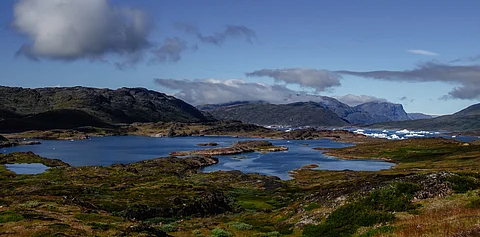

Over 7,500 lakes in western Greenland underwent a fundamental ecological transformation owing to extreme climatic conditions. Atmospheric rivers transformed them from being carbon sinks to sources, a new study has revealed.
The researchers found that compound climate extremes during September 2022, such as record heat followed by rains due to atmospheric rivers, altered the numerous biogeochemical, physical, and biological features of these lakes.
Atmospheric rivers (ARs) are defined as relatively long, narrow regions in the atmosphere — like rivers in the sky — that transport most of the water vapour outside of the tropics, according to National Oceanic and Atmospheric Administration (NOAA).
Lakes are an important element in the Arctic landscape as they serve as sites of intense mineralisation of terrestrially derived organic carbon. The study published in Proceedings of the National Academy of Sciences (PNAS) said with increasing warming at the higher latitudes, over 3.5 million lakes are at the risk of ecosystem transformation.
In September 2022, western Greenland experienced a series of atmospheric rivers, causing temperatures to remain above normal — meaning majority of precipitation fell as rain rather than snow.
By the end of the month, the remnants of Hurricane Fiona brought warm temperatures and record melting of the Greenland Ice Sheet, the study noted.
Nearly a year later, ARs caused the wettest and warmest July since 1940 in 2023.
The heat also caused permafrost — frozen soil that stores a significant amount of organic carbon — to thaw, releasing an abundance of carbon, iron, magnesium and other elements, the scientists said in a statement.
The influx of materials from watersheds heavily affected the physical features of the lakes, transforming these ecosystems.
“Remote sensing suggests that an extensive and spatially heterogeneous area of the west Greenland landscape was affected by these storms, with the wetter soil conditions resulting collectively from the autumn 2022 and summer 2023 precipitation leading to a mosaic of terrestrial greening as indicated by higher Normalised Difference Vegetation Index,” the study observed.
As a result of the changes, the average lake water Dissolved Organic Carbon (DOC) concentrations increased by 22 per cent compared to its 2013-2022 averages, the scientists said.
The blue colour of the lakes turned into darkly stained brown within a year which, scientists said, is a phenomenon comparable to what occurs in boreal lake history over thousands of years. The change in water colour remained persistent until July 2024.
The browning of the lake reduced the light penetration by 50 per cent across the lakes.
The altered physical and chemical properties and reduction in light decreased the biodiversity of plankton, resulting in severe impacts on the region’s carbon cycle, the scientists said.
“Lakes shifted from being summer carbon sinks to sources, with a more than 350 per cent increase in carbon dioxide flux from lakes to the atmosphere,” the study noted.
The methane concentrations were also 72 per cent higher in August 2023, compared to samples taken during the same time in 2014.
The scientists pointed out that ecosystem transformations continuing for long time can cause serious long-lasting ramifications on ecological and humans.
Citing an example of the devastating nature of ecosystem transformation driven by ARs during the 1861-62 winter mega flood in California, followed by decades of drought; the study said a number of regions of the state flooded and became brown for months.
“While this ecosystem transformation eventually reverted, the economic impacts were staggering, with 25 per cent of the state’s economy destroyed and the state of California declaring bankruptcy as a result,” it noted.
They said the transformation of western Greenland’s lake ecosystems driven by a series of ARs persisted through the summer of 2024.
“It remains to be seen if and when they might revert back to a blue state. Our results reveal that, while in their darker, brown state, these lakes are a larger source of GHGs, and tens of thousands of lakes in west Greenland were affected by these compound climate extreme events,” it said.
The deterioration of water quality impacted Greenlandic communities who rely on lakes for drinking water as it affected taste and caused odour problems besides posing multiple health risks.
The scientists concluded that lake ecosystems of west Greenland coherently crossed a tipping point owing to compound climate extremes, underscoring the value of better integrating the potential for such surprises into future scenarios and adaptation plans.